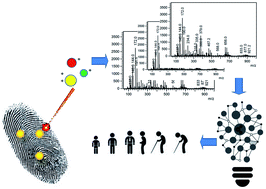Exploring the problem of determining human age from fingermarks using MALDI MS-machine learning combined approaches†
Abstract
For over a century fingerprints have been predominantly used as a means of biometric identification. Notwithstanding, the unique pattern of lines that can contribute to identifying a suspect is made up of molecules originating from touch chemistry (contaminants) as well as from within the body. It is the latter class of molecules that could provide additional information about a suspect, such as lifestyle, as well as physiological, pharmacological and pathological states. An example of the physiological state (and semi-biometric information) is the sex of an individual; recent investigations have demonstrated the opportunity to determine the sex of an individual with an 86% accuracy of prediction based on the peptidic/protein profile of their fingerprints. In the study presented here, the first of its kind, a range of supervised learning predictive methods have been evaluated to explore the depth of the issue connected to human age determination from fingermarks exploiting again the differential presence of peptides and small proteins. A number of observations could be made providing (i) an understanding of the more appropriate study design for this kind of investigation, (ii) the most promising prediction model to test within future work and (iii) the deeper issues relating to this type of determination and concerning a mismatch between chronological and biological ages. Particularly resolving point (iii) is crucial to the success in determining the age of an individual from the molecular composition of their fingermark.

- This article is part of the themed collection: Analytical Methods HOT Articles 2022


 Please wait while we load your content...
Please wait while we load your content...